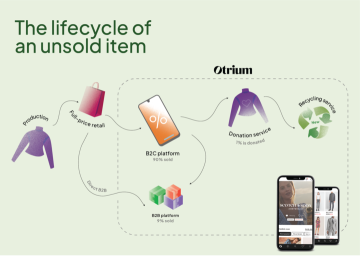NEWS
Otrium's Recycling Service

“We want to unburden our Fashion Brand Partners to maximise margins while extending the life cycle of fashion items.”
20 JUNE 2024
In our last blog post, we talked about the challenge of damaged returns, and how we give half of these items a second chance on our platform through repairs. Unburdening our Fashion Brand Partners to maximise margins while preventing these pieces from going to waste.
The other half of these items cannot be restored to perfect condition. We provide a few alternative routes to repurpose these items. Our Fashion Brand Partners get presented the options to either sell these to stock buyers or receive them back at their warehouse to repurpose in other ways. The last option is not ideal as this creates a double logistical movement: from the Otrium warehouse → to the partner’s warehouse → to the partner’s recycling partner. Resulting in additional costs, and climate impact coming from packaging and logistics.
In May 2024, we teamed up with Fashion to Fiber and Frankenhuis (both part of Boer Groep) to offer local mechanic textile recycling as an alternative for sending these items back to the warehouses of our Fashion Brand Partners. The items are collected in reusable bags and moved from our warehouse to Frankenhuis, which is across the street.

How the recycling process works
- Receive items: Frankenhuis receives the items through Fashion to Fiber in reusable bags
- Sort: Items are sorted based on raw material and quality
- Recycle: Items are recycled through fiberization (pulling apart textiles into fibres), cutting (making small pieces of the textiles) and/or grinding (granulating textiles into a powder structure)
- Materialise: The fibres and granules are processed into “new” materials for reuse across various industries. Frankenhuis has four main recycled materials:
- Longer fibres that are suitable for the spinning industry
- Shorter fibres that are used in automotive and non-woven industries
- Filling materials for products such as furniture and punching bags
- Powder which is used for chemical textile recycling to create viscose yarns or as raw material for the paper industry
- Report: Reporting on recycling results, what volumes could be recycled into what materials
Depending on the quality and composition of the garments, some may be unsuitable for recycling and will regrettably need to be classified as waste. To reduce the impact, this will be incinerated for energy recovery.
Looking ahead, we aim to find more ways to repurpose damaged items. By combining commercial data, physical properties, and brand preferences. We want to unburden our Fashion Brand Partners to maximise margins while extending the life cycle of fashion items. Paving the way for a better future for fashion, one item at a time.
More from Otrium
See all articles
Returns are a significant challenge in the current e-commerce landscape. Apart from the negative financial impact, not all items can be put back into undefined. While some unsellable returns are donated to charities, others are being destroyed. In Europe one out of every five pieces of clothing is undefined. At Otrium, we recognise the importance of extending the life cycle of clothing, while reducing waste. That's why we've set up our Repair Service.Refurbishment, often referred to as repair or reconditioning service, is a service we offer to our fashion brand partners. We repair slightly damaged returns to perfect condition, giving them a second chance on our platform. Since April 2023, we have partnered with The Renewal Workshop via our logistics partner, Bleckmann. In 2023, we sorted and graded over 30,000 items, of which around 50% were successfully brought back to their original condition.How it worksundefinedundefinedundefinedundefinedundefined

At Otrium, our goal is to ensure all clothing produced is worn. Over 90% of the items available on our platform reach our members. We offer alternative services to unburden fashion brands to repurpose the unsold 10%. Alongside our B2B Marketplace – where we connect our brand partners to local stock buyers – we actively support charities to repurpose the items while serving local communities.How it worksPreviously, Otrium would return unsold items to our brand partners, operating on a consignment basis where brands retain ownership until items find new owners through our platform's data-driven matching. Our donation service operates as an additional facet of our core mission, which involves giving unsold fashion items a renewed purpose. We enable these charities to select items upfront. To ensure that the items we send their way fit with the needs of their community. Partnerships with charities show us the importance clothing holds.

Conscious
Conscious Series: So Good To Wear
Otrium continually works towards the mission that all clothing should be worn. We do this by helping to eliminate unsold inventory and using technology and data to change the way clothing is created and sold. We are looking to highlight brands in a positive way and help our customers make more informed choices.This week, we chatted to Eric Otten, CEO of cashmere brand So Good To Wear, who believes that ethical fashion should be the rule instead of the exception. So what does sustainability mean to you? “People have always thought we could take something inexhaustible from our earth, to drive mass consumption and economic growth. Unfortunately, the reality is the opposite. Sustainability means that we have to give back more to the earth than we take” Tell us more about your brand. “Cashmere without compromises sums it up. We redesign the production process of cashmere with new and restored values. It’s a more conscious and personal process.” What’s your role… and how did you get there? “As CEO of the company, I have to be a farmer for our Nepalese business and at the same time a fashion specialist for our western business. I bring those two worlds together, always with consideration of our vision and goals.” What’s your career background and when did you start working on creating a positive impact? “I have been in the fashion business for almost my whole career. I worked for private label brands and premium brands like Wolford. After five years, I truly realised there are no limitations for the welfare of our planet and so I joined the sustainable and fair trade brand MYoMY. From there, I moved to So Good To Wear.” What achievement are you most proud of? “Putting the whole chain theory in practice! From our own cashmere goats to our spinnery, natural dying atelier and production in Nepal to our “slow fashion” models in the retail industry. The whole chain is fairtrade, animal friendly and committed to rebuilding the economy in Nepal.”What are you working on at the moment? “We are expanding our retail network internationally and expanding our own cashmere goat herd in Nepal.”What is the biggest challenge on your roadmap of improvements? “The coordination between high demands in the western world and the limitations of the relatively primitive possibilities in Nepal. Some things take more time to realise in Nepal – time we sometimes don’t have.”What’s the best feedback you’ve ever received from customers? “I have never worn a more comfortable piece of clothing than my So Good To Wear sweater – it’s physical and emotional.”What do customers value most about the brand and products? “It’s high “slow” fashion without compromises, made from the finest quality cashmere, fully fairtrade, sustainable and animal friendly”Who inspires you and why? “Stella McCartney – it became a movement of a luxury fashion brand built on sustainability.” What’s the most important aspect you keep in mind when shopping for more sustainable fashion? “I ask: is the brand really concerned about sustainability or is it a form of “greenwashing”?”Do you have a quote you live by? “Without action, we only have words.” What’s a quick change that people could make in terms of being more sustainable? “Actually, that is very easy! Start changing small and easy things in your life because it all helps: take your bike, not your car, don’t let the water run when you brush your teeth, don’t throw away food, put the light out in rooms you're not in, wash only a full machine and use biological soap, throw waste in a bin, not on the street, don’t eat meat every day and many more things that make more difference than you think, in your head and for nature.”
Schrijf je in voor onze nieuwsbrief
Ontvang de nieuwste kortingen, merken en drops.
Otrium
Klantenservice
Klantenservice
© 2016-2025 Otrium, behalve bepaalde inhoud geleverd door derden
